How Has Natural Medicine Impacted My Life? - Part 2 - Kombucha and Water Kefir - My response to @naturalmedicine's question, with ALL SBDs pledged to #tarc
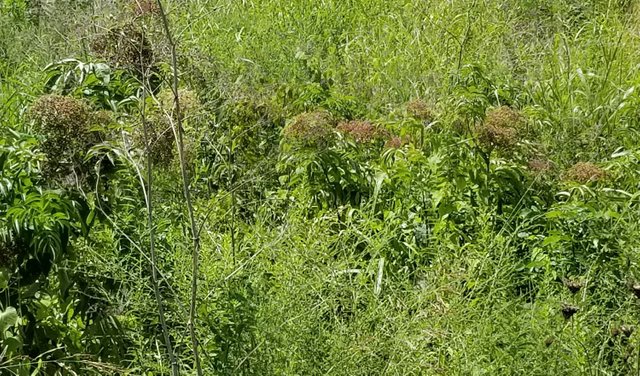
Elderberry Bushes in Field with Ripening Berries

Natural medicine and alternative healing have been a big part of my life pretty much since I was born, thanks to my mother, her mother and her grandmother, all of whom were wise women, natural (organic) gardeners, and lay herbalists.
And all were exceptional at what we now call medicinal cooking, though, at the time, they would simply have called it cooking. They were natural healers, as many mothers are, and/or become with experience through the years.
But, even though I was raised with their healing expertise, what they were doing was simply "how it was done" in my mind, and I thought everyones' moms could do the same.

In fact, it wasn't until my father bought a small health food store, when I was a sophomore in high school, that I realized how truly exceptional these women were, and how uncommon their knowledge and expertise was becoming, as more and more people forgot (or were simply never taught) the traditional healing methods of their forbears.
And, had it not been for forward-thinking herbalists such as Juliette di Bairicli-Levy, and the generations of herbalists that she in turn inspired, such as Rosemary Gladstar, Susun Weed, myself, and many others, we would likely have lost far more knowledge of natural medicinal remedies and, yes, even cures, from around the world.
As in every human endeavour, when it comes to natural medicine and traditional healing knowledge, we stand on the shoulders of giants.

Yesterday I mentioned my love for elderberry, my years-long love for making elderberry syrup, and how many uses we had for the bounty from our prolific elderberry bush in our Largo, Florida, back yard.
What I did not mention was that, prior to realizing what it was, I damned near mowed the plant down, as it was an out-of-place volunteer midway between my two beloved pink grapefruit trees.
But happily, about that time, I had ordered a number of fruiting plants and bushes from a grower in the Orlando area. When looking at the leaves of the two starter elderberry bushes, that I had initially planted in pots, I recognized their resemblance to the leaves on the much-larger bird-planted bush in our yard. Good thing, too!

Interestingly, my two purchased elderberries, which as I recall were varieties Adams and Johns, never did a thing . . . one died immediately after I planted it in the yard, and the other hung on for a few months longer, but never thrived, despite being in a similar exposure and roughly ten feet from the volunteer bush, which thrived for years.
It was still thriving - and producing abundantly - when we finally sold the house and moved to Tennessee.
Not only the berries are medicinal, but the flowers are also considered to be highly medicinal, and are edible too! Elderberry fritters are legendary, which are made from the flower umbels, which are dipped in batter, then deep fried, and often sprinkled with powdered sugar.

There are numerous recipes for elderberry cordials, liqueurs and wines made from the flowers, as well as many made from the berries.
The entire plant, apart from the flowers and berries, is poisonous. Thus the typical advice is to avoid including the stems, which are mildly toxic, but in the case of fritters, I literally know of no one who bothers to remove them, or has gotten sick as a result. Use your best judgment.
Elder flowers are highly attractive to bees and butterflies, and the ripening berries, if the birds don't strip them first, can last well into winter.
They can even be used after drying on the bush, should they do so, by reconstituting them by simmering them in water. I've made a lot of elderberry syrup from reconstituted berries.

Ripe elderberries were the number one favorite treat of our doves . . . I just put a ripe umbel in their cage, and they strip the elderberries quickly. They love them.
Of course, here in Tennessee, I've yet to beat the birds and deer to the berries, but having found such a large patch of bushes, I'm hopeful for this year.
The one elderberry bush that I've started from a cutting thus far is doing well, and growing, so I am hopeful that, when I plant it near our black walnuts come fall, it will thrive and bear heavily next season. Wish us luck!

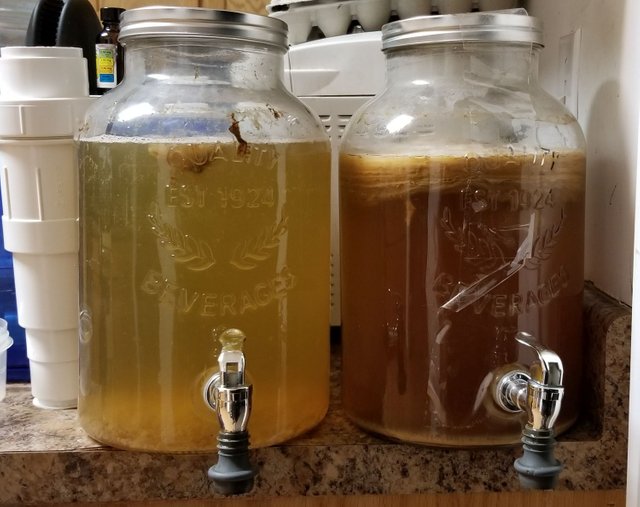
Our last set of Continuous Ferment jars, with metal lids that did NOT stand up well to Kombucha

Then there is kombucha and water kefir, which, when combined, comprise my favorite daily drink, which help to keep me well-hydrated and healthy throughout the year.
Many people already know that kombucha is a fermented probiotic drink that aids digestion, helps to alkalize the body, and provides a whole host of other health benefits, inside and outside the body.
Water kefir is less well known in the U.S., though it is extremely popular in other countries such as Japan and parts of Europe, and is fermented from a culture somewhat similar to that used for kombucha, though sweetened water is used, rather than sweetened tea.

Given the choice of one or the other, I typically choose kombucha, both because I love green tea, and because water kefir is more often more sweet than tart, whereas kombucha is more often better balanced from a taste perspective.
Once I was making both at home, I began mixing them as an experiment, and liked it so well that I have continued doing so, though the proportions change over time depending upion the ripeness of the various ferments.

Although continuously fermenting kombucha is not uncommon, I was flat out told by several people that it was not possible to do so with water kefir, which has turned out to be entirely incorrect.
While it is true that continuously fermenting water kefir changes the culture somewhat, and makes it grow considerably more slowly, I find that as with kombucha, continuously fermenting makes the culture, and the resulting fermented drink, grow more complex and flavorful over time.
I have been continuously fermenting kombucha for roughly five years now, and water kefir for about three years, so it is entirely possible, though I have found that keeping a portion of the culture separate, in order to freshen the continuous culture from time to time, is advisable.

The biggest advantage to continuous fermenting is that, especially for kombucha, you don't have to wait a week between batches before it is ready to drink.
With continuous brewing, you simply draw off the amount of finished kombucha or water kefir that you want to drink, via the spigot in the jar, and add sweetened tea (or sweetened water, for water kefir) to make up for what you have drawn off.
And it is not necessary to do so immediately; you can wait a day or two without any adverse effects on the finished brew, though if you wait too long, the brew can become overly acidic. But that is easily remedied by adding more sweetened tea (or water).

I got interested in continuous fermenting kombucha several years ago, but the requisite fermenting crocks can be quite expensive, and as the cheapest starter kit I found at the time was well over $300, I put the idea on the back burner.
Then I discovered lemonade and iced tea dispensers, made of glass, which are commonly available every spring and summer, and in some places throughout the year.
I have gone through several, to find what I like best, and have been pleased overall with the way they performed, though most have lids that either corrode in the presence of acidity, or don't provide a secure enough seal to keep out fruit flies and ants.

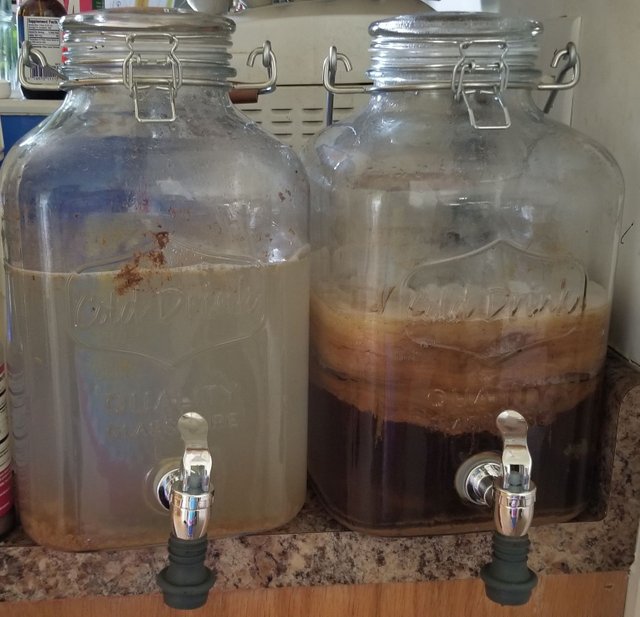
Water Kefir and Kombucha in 2-Gallon Continuous Ferment Swing-top Jars with Spigots

Our current swing-top 2-gallon containers, which we got at our local Walmart for about $17 each, make continuous fermenting an easy and painless process, and give us a perfect seal, as no metal comes in contact with the liquid, and there are therefore no issues with rust or corrosion.
Additionally, as the lids are cinched down over the rubber gasket by the metal closure, there is no way for ants or fruit flies to gain access, keeping the resulting ferment far cleaner and much less likely to be contaminated.
The swing tops also function as virtual airlocks, as any gasses that build pressure inside the container are allowed to escape, while excess air is prevented from entering.
You may also notice that we have the spigots covered; these are rubber wine corks, originally intended to be used with a vacuum sealer for wine bottles, but which we have pressed into service to keep fruit flies and ants from entering our containers from the spigot, and thus ending up in our glasses or drinking bottles.

The basic instructions are to obtain a good kombucha culture, or grow your own SCOBY over a week or more, transfer the SCOBY and the finished kombucha into an appropriate container, then draw off the finished kombucha as needed, add sweetened tea to replace what you have drawn off.
You can begin either with a purchased SCOBY (which stands for Symbiotic Culture of Bacteria and Yeast), or purchase a bottle of plain organic live (unpasteurized) kombucha, and grow your own SCOBY, by pouring the kombucha in a glass or jar, covering it for a week or so with a washcloth or kitchen towel, and using the mass that grows on top as your starter culture.
I use Gunpowder green tea, a scant half-teaspoon per quart due to its highly concentrated nature, and 1/3 cup of raw, organic cane sugar.
Once cooled to room temperature, I stir long enough for the sugar to be completely dissolved, add the sweetened tea to the top of the container, pouring slowly so as not to disturb the SCOBY too much, though the latter will right itself, even if it initially winds up askew.

We typically draw off anywhere from 1/2 liter to 1 1/2 litres per day, and sometimes more, from a container that holds approximately 2 US gallons, or a bit over 7.57 litres.
As long as you leave approximately half of the kombucha in the jar before refilling, it should be ready to draw more off to drink the following day, and will have a lovely sweet-tart flavor, somewhat reminiscent to well-made lemonade.
Those who consider kombucha to be too acidic are typically overfermenting it, and with a shorter ferment time, they will likely find it much more to their liking.
Over time, the SCOBY grows larger and thicker, and takes up more room, so every so often, which for me is about every six months, I empty the lot, clean it really well, separate the top 1/4" thickness or so of SCOBY from the rest of the mass, rinse it well, and begin again.

Water kefir is made similarly, though the culture, rather than forming a rubbery-looking mass at the top, consists of small grains that look a bit like translucent cooked tapioca. If fermenting in jars, as is typically done, water kefir is fermented in 48 hours, versus roughly a week for kombucha.
Additionally, water kefir grains grow quite rapidly, in warm conditions sometimes doubling their bulk in a single batch, leading to lots of extra grains over time. These can be split between several jars, given to friends, or sprinkled over salads, as they have a light, mildly sweet taste, and are almost pure probiotics.
The water kefir grains can also be added to your pet's food.

When continuously fermenting water kefir, the grains continue to grow, but far more slowly, and you may find a brownish scum forming on the top and upper sides of the container, which is formed by the yeasts in the culture.
This is harmless, can simply be removed with a spoon or fork, and is a fabulous addition to compost, as the beneficial bacteria help to break down organic matter quickly.
In a two-gallon container, I start with about a cup of grains, which will ferment to the point where I like it in 24 - 36 hours the first time.
From there, as you are drawing off the finished water kefir, and adding back sweetened water, it is fairly easy to maintain a good taste balance.

Aside from all the health benefits of drinking water kefir and kombucha, both are also highly beneficial for the skin, and can be used in place of toner and/or lotion.
In fact, when I replaced my pricey cosmetic toner with kombucha in a spray bottle, the condition of my skin improved greatly, it stayed hydrated longer even without lotions and moisturizers, and it felt softer and smoother than it did before I started toning with kombucha.
And it is not only good for the skin on your face, but also for that on your entire body. I have found that, particularly in winter, when my skin tends to get dry and flaky, my skin stays hydrated and much smoother, including the skin on my legs and feet, when I use kombucha as a post-shower spray. It makes a huge difference, at least for my skin.
Although water kefir can also be used, and is also beneficial, for this particular case I use kombucha exclusively, as its effects are far more pronounced, which I'm guessing is due at least in part to the properties in the green tea that is used as its base.

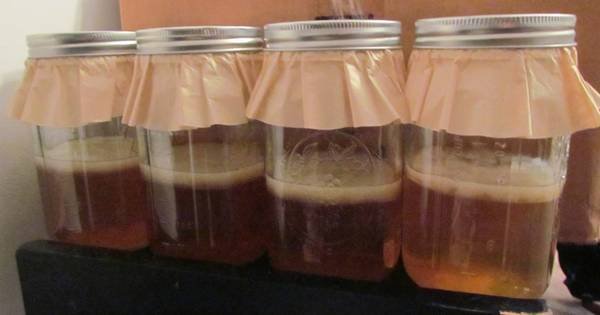
Kombucha Kits in Quart-sized Jars, Ready to Go

The SCOBY itself can be quite useful itself, including the extra SCOBY left over after periodic cleaning of the continuous fermenting container, and is useful in some surprising ways.
First, and most obviously, small pieces of SCOBY can be added to jars, that are then topped off with sweetened tea, to create kombucha kits, which may be given away, used as favors, or sold.
Ideally, the container in which kombucha is fermented is covered with a permeable layer, such as a kitchen towel or coffee filter, but here in the humid South, a less permeable covering is required, at least if you don't want to attract every fruit fly for miles around.
Another use is
Another use is for layers of SCOBY to be air dried, and used to make a form of vegetable leather, which I understand can actually be used to patch leather garments. Some experimentation will be required, as a rather thick SCOBY will dry to a very thin piece of vegetable leather, and I have yet to find anyone who gives even rules of thumb, much less detailed information. But I definitely intend to try it out for myself.

A third use is for smaller pieces of SCOBY to be air dried, in sizes suitable for use as bandaids, and they are moistened slightly before use. The beneficial bacteria in the SCOBY are thought to prevent infection and speed healing.
The kombucha itself can be added to rye flour, or other flours, and made into sourdough-like breads, pancakes and more, with far less fuss than keeping a sourdough starter going for months or years at a time. Worth a try.
Finally, both kombucha and water kefir are ridiculously healthy - when I first started making my own kombucha, I dropped about fifteen or twenty pounds in a short period of time, and kept it off, simply by drinking kombucha daily, with no other changes to my diet or exercise program.
Mohandas Gandhi, when he went on his hunger strike to protest the ongoing British occupation of India, is reported to have subsisted on nothing other than kombucha.
And this post merely scratches the surface . . . I haven't even touched on second ferments, making your own healthy sodas, flavoring finished brews with fruits, herbs and spices, the many and varied uses for kombucha vinegars, or much, much more.
Give them a try - your digestion, your health, and your taste buds, will thank you!

For those who don't know, @rhondak runs a volunteer dog rescue from her home in Virginia, damned near singlehandedly, and could seriously use our help. She currently has forty dogs in her care, my understanding is that they are mostly larger breeds such as Walker Coonhounds, and she is paying for their care herself, without the benefit of local donations.
All of these dogs require daily feeding, proper veterinary care, to be spayed or neutered prior to adoption, and LOTS of love, time and attention.
Let's all show Rhonda how awesome the Steemit community is, and how much we appreciate her love and hard work on behalf of these dogs, and help her out, each to the best of our own ability. Thank you.

#ecotrain #ghsc #thirtydayhaikuchallenge #steemsugars #teamgirlpowa #womenofsteemit #steemusa #qurator #steemitbasicincome #knot #bethechange #chooselove #naturephotography #photography #neighbors #beauty #love #animals #dogs #rescue #adoption #spayandneuter #homesteading #permaculture #naturalhealing #naturalmedicine #dogrescue #dogsofsteemit #grace #poetry #philosophy #beablessing #kittylove #catsofsteemit #truffle #newkitten #catrescue #kitten





art and flair courtesy of @PegasusPhysics

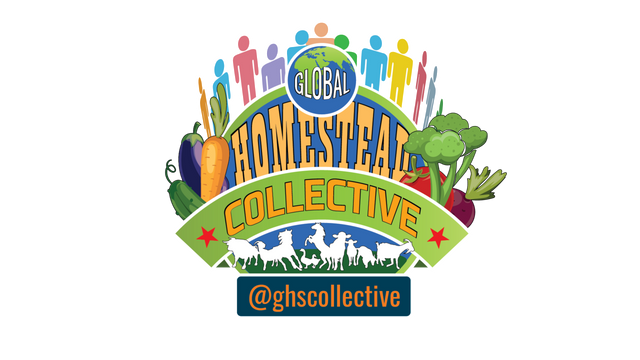

I have been fermenting tea for a few months, and I will try the water. We rescue Dachshunds here, so I know what a labor of love the dog rescue is. The drying of the SCOBY for leather is an interesting idea.
Nice post, I read it all.
:)Thanks for your lovely comment.
Nice to know my posts are actually being read, and not just autovoted. ;-)
As for regular ferments, I prefer kombucha, but find that although water kefir tends to be less complex overall, I still prefer the combination of the two over one or the other.
But, water kefir, when given a second ferment, can become as complex and flavorful as a good wine, so both have their place.
Great ferments, both.
I will see what I can do, I have a lot of fermenting going on here. We have eaten some wonderful sauerkraut and the tea of course.
You put a lot in there, I will re-read it so I can pick up what I missed.
:)Re-steemed it so my friends can enjoy it too.
Thanks so much for the resteem! I'm very glad that you have found the post valuable.
I learn every day! This article was useful to me, and I learned more about tea, which will help me with the fermenting I have planned.
:)This is fantastic and really timely for me as I was just given some kefir grains and I'm not sure how to brew them but this post explains things a little. So the kefir grains eats up all the that sugar? I will share and up vote this with natural medicine when I switch accounts my dear this is absolutely fabulous.
My pleasure - glad to be of service!
That said, I highly recommend first using the jar method, especially as they ferment so quickly, and build up your stores of grains before you go for the continuous ferment method.
I'm basically lazy, so tried it just to see if it could be done, but although the grains will continue fermenting using that method for a year or more, they will never again grow as quickly as will fresh grains using the jar method.
And, since you will ultimately want to refresh your grains in the continuous ferment system, it is best to keep a separate strain going, so you won't be forced to beg, borrow or steal more when that time comes. ;-)
Good luck - I hope you love it as much as we do!
The jar method is basically done in a quart-sized jar, preferably (but not necessarily) wide mouth.
To each quart of room temperature water, add 1/3 cup of raw organic cane sugar, or you can use evaporated cane juice, which the grains really love. You can also use a combo of the two. Mix really well, until sugar is completely dissolved, before pouring into the jar and adding the grains. You will likely have a small amount left over, which can be refrigerated until your next use.
Cover the jar with a lid, or a permeable cover. Good options include a coffee filter held in place with the outside screw part of a two-piece canning lid, a wash cloth or kitchen towel held in place with a rubber band, or one of the plastic mason jar tops. I've used all three at various times with excellent results.
Leave on the counter to ferment, and know that it ferments much faster in warmer temperatures. I prefer mine sweet-tart, rather than really sweet, so I typically allow it to ferment for 48 hours, though it can go longer without becoming acidic. Water kefir takes MUCH longer to get acidic than does kombucha.
When you drink or decant, it is best to pour through a plastic strainer, and to rinse the grains briefly with fresh sweetened water (preferably room temperature) before placing back in the jar again, but it is not strictly necessary to do so every time. I'll often just pour off a portion to drink, leaving some of the water kefir in the jar, and simply top it off; though once a week or so, I do pour it all out through a plastic strainer, and rinse the grains properly.
Any extra water kefir you can store in a screw-top, corked or swing top bottle, allowing a second ferment, with or without additional flavorings, and make your own healthy "sodas," some of which develop the complexity and mouthfeel of a nice wine, without the alcohol content.
Serious deliciousness ahead. ;-)
This is EXACTLY what I needed. Thanks so much. How long will they live without feeding? I have hjust been given some but have to time to tend them until about Wednesday!
Copying this to my notebook!!! Thanks again! Really appreciate it xxx
You're welcome!
It all comes with a bit of a learning curve, and there is a lot of misinformation out there, but it is so delicious and useful that it's more than worthwhile.
Oooh, I am going to become your student.
I discovered a nonspreading cultivar of Japanese Knotweed on my property last year in much the same way--totally by accident. I blogged about it, and since have learned to use both the root and the stems to make itadori tea. I also use a lot of Joe Pye and goldnerod for kidney health and eat most of the leafy weeds I have growing in the yard.
Elderberries interest me. This is a plant I've heard of often but am not personally familiar with. I shall go on an elderberry hunt very soon in hopes of finding some on my land. :-)
The nonspreading variety of Japanese knotweed interests me, as I prefer sticking with plants that won't take over our woods any worse than they already are, but for the most part I'm trying to bring in the native plants and herbs that were common here prior to European invasion and subsequent overharvesting. (My own heritage straddles both sides).
That said, I have a couple dozen goji berry (wolfberry in California) bushes I'll be planting once the weather really cools down, so I'm not strictly going native, but I am limiting non-natives to those known to be noninvasive in this climate.
My overall goal for this place is to eliminate (insofar as is possible) the non-native invasives, to bring back the nativeplant communities they supplanted, to reestablish the mycological symbiotic relationships that existed here for thousands of years, and especially, to reestablish American chestnuts as the dominant tree species in our woods.
My ultimate goal is for my property to serve as a living seed bank for the Calfkiller River, and eventually, for the entire Caney Fork watershed.
And yes, I realize that the chestnuts may well have to be hybrids, and not pure American chestnut, especially since it is pretty clear that we may well have blight here.
I planted three Dunstan chestnuts three years ago, which are American x Chinese hybrids that are claimed to have never been killed by blight.
One failed to make it through the first winter. After the second winter, one tree made it through fine, but the second, though it leafed out when the first did, died back to the ground within four to six weeks.
I was surprised this spring, when it resprouted from the ground once more, so my plan is to plant horseradish at the base, and see if possibly that offers some protection. I'm also watering with neem oil, which is also antifungal, in hopes that if it is blight, it will stop it in its tracks.
Interestingly, all three trees had the remains of blossoms when I purchased them in the fall, three years ago. None of the trees have flowered since, so it's pretty clear that they are not particularly happy where they are.
Looking now for alternatives, since Dunstans don't seem to be especially appropriate for our area. I'll try them again, particularly along the river where the moisture level is more consistent, as my trees were end-of-season closeouts from Walmart, and may simply be reflecting the lack of care they received while there.
I'll be contacting Tennessee Tech, since I understand they have an ongoing chestnut breeding program, which means that (hopefully) anything they develop should work well on my place, as they are a mere twenty miles north of me.
Wish me luck - I am seeking a variety that has far more American characteristics than Japanese or Chinese, meaning tall, fast-growing spreading tree, with excellent quality timber; not a shrubby bush.
Not an easy task.
Oooh, let me know how it goes with the chestnut trees. Part of the rescue house is built with the old wormy chestnut. I look at it and think it's such a shame that those trees won't grow anymore.
Here's the post I made about my "Crimson Beauty" knotweed bush. I think it's so cool that I was able to trace it back to the nursery that propagated it. :-)
https://steemit.com/colorchallenge/@rhondak/color-challenge-thursday-green-itadori-tea-with-leaves
Yeah, I'm still learning too!
When I moved from California to Florida, I had to relearn native plants all over again, and the same thing occurred when moving from Florida to Tennessee . . . yes, with both being in the South, there are a lot of plants in common, but in moving from Zone 9b to Zone 6b, there are a whole lot more plants that are NOT in common, and that's not even counting the invasives.
I did spend three summers here attending regular plant walks with a guy teaching about the native and non-native edibles in the area; and with the Cumberland Mycology Association, learning a lot about the herbs and mushrooms we have here, but the fact remains that with everything I learn, the more I realize that I don't know.
Which keeps me fascinated.
There are still a vast majority of plants and fungi that I don't recognize by sight, and I have to hit the books or a decent search engine to identify with any certainty, especially as so many edibles have poisonous lookalikes.
I'm a big believer in erring on the side of caution. Especially with mushrooms, if Marek isn't around, since he's been mushrooming since he was a kid, I stick to the varieties that I know don't have toxic lookalikes.
I haven't yet forayed into wild mushrooms. Too risky for this old girl. But I'll eat the ones I buy in the store all day long. LOL
I never really had, either, until Marek and I got together.
But, being from Poland, he and his family had gone mushrooming from the time he was a kid, and as he found a great spot for really good boletes, really close to our home, he got me hooked.
That said, I stick with the ones with no toxic lookalikes, as I know how difficult it can be to identify some of them, and I'd just as soon not meet an untimely end in an entirely preventable way. ;-)
What an amazing, info-packed post. Resteeming...
Posted using Partiko Android
Thanks, I'm so glad you found it useful!
Posted using Partiko Android
TOO LATE to resteem this one - oh no! - but I can still Tweet and FB share, so there's that. Thanks, Herbalist Master, for this - inspiring! - how lucky you are to have women in your life who modeled natural healing and taught you what they knew. Now I'm trying to acquire a taste for the healthy stuff. Mom came from a long line of European pie bakers. Cakes, cookies, breads, potatoes, garden veggies (there was that!), but most of all CARBS and SUGAR, and it's in my DNA. Bring on the kombucha and sauerkraut... hide the sweets!
Yeah, we had our share of baking going too, though my mom always did her best to throw some nutrition in there with all the sugar.
Her oatmeal cookies (now mine) are still the best, made with LOTS of eggs, and I've actually modified the recipe slightly so my version is gluten free and uses coconut sugar instead of refined white sugar, so they're a whole bunch healthier than once upon a time.
And still completely yummy.
Mushrooms. The most horrific scene in a Willa Cather novel is when Antonia's family in a fit of generosity and gratitude decide to part with some treasure brought back from the Old World, something dried, wrinkly and dark, as a gift to their neighbors.... who sniff the "treasure" later on, and toss it all into the fire.....
The misunderstood but valuable contribution of the Shimerdas to the Burdens, the dried mushrooms, represent the inability of people like the Burdens to value and make use of the Old World. Mrs. Burden, seeing no use for them, just throws them away. But for the Shimerdas, the mushrooms were a tasty addition to meat sauces. The metaphor suggests how people adapt to their new environment in various ways and at various speeds. Some cling on to the old ways; others innovate in the new land. Without making the Burdens look hardheaded and xenophobic, this metaphor shows that they are sometimes quick to dismiss the strange ways of their foreign neighbors. My Antonia: Metaphor Analysis
LOLOL, we have our own version of that here.
In Poland, sarniac is one of the prime gourmet mushrooms that is highly prized and sought after every autumn. So imagine Marek's delight, the first year we lived here, when he discovered a large patch of sarniac mushrooms on our place, near the original home on the property. Prolific and easy to get to . . . woo hoo!!!
His dad was even more thrilled, as sarniac are almost never sold fresh in the States, and are extremely pricey dried, especially when flown in from Poland.
And imagine how thrilled they were to initiate me into the mystical realm of this culinary delight . . . only to discover that, while I am a long-avowed mushroom nut, I truly can't stand the taste of sarniac, which strike my cultured papate as something akin to a blend of industrial waste and battery acid. Blech.
I promptly told them they could have every single sarniac on the place. No, really. Take them. All. Please.
That said, at least I didn't throw them into the fire. I'm thrilled that they love them so much. I just don't want any. Ever. ;-)
Oh, I love it! Whenever someone spurns our asparagus and rhubarb, I just say good, that much more for me. The Midwest is known for morrels, and I've never acquired a taste for them. Too hard to soak 'em in salt water long enough to get the sand loose, and rinse all the sand out. Maybe it's the soil I find them on, but that grit on my teeth is nasty. So, you can have all the morrels, and I'll hog the asparagus.
Woo hoo! Yet another area of agreement.
Asparagus and artichoke are my two favorite vegetables. Hands down. I'll take them over all comers.
And yeah, funnily enough, one of the things that made us choose this particular property was that, the first time we came here, we found an ancient morel.
And, in closing in on seven years here, we have literally never seen another here. At all. ;-)
On the other hand, we do have blue and yellow chanterelles, and LOTS of boletes, so life is good.
And one of my plans for this place has long been to bring in lots of other native mushrooms and herbs, which bit by bit, we've been doing each season.
I really want to inoculate a couple of our oaks with hen of the woods mushrooms. Pure deliciousness. ;-)